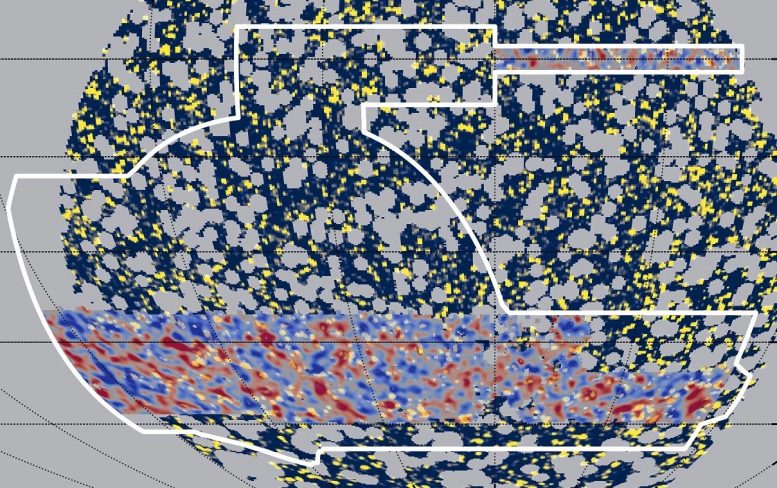
In a new study, astrophysicists have found a certain gamma-ray glow in the sky, known as unresolved gamma-ray background (yellow), to coincide with cosmic regions that contain a lot of matter (red). The correlation could lead to a better understanding of highly energetic astrophysical objects and dark matter. The gamma-ray map was created with nine years of data from the Fermi spacecraft, and the map showing the density of matter is based on one year of data from the Dark Energy Survey (DES). Credit: Daniel Gruen/SLAC/Stanford, Chihway Chang/University of Chicago, Alex Drlica-Wagner/Fermilab
Matching up maps of matter and light from the Dark Energy Survey and Fermi Gamma-ray Space Telescope may help astrophysicists understand what causes a faint cosmic gamma-ray glow.
Astrophysicists have come a step closer to understanding the origin of a faint glow of gamma rays covering the night sky. They found that this light is brighter in regions that contain a lot of matter and dimmer where matter is sparser – a correlation that could help them narrow down the properties of exotic astrophysical objects and invisible dark matter.
“What’s really intriguing is that the correlation we measured doesn’t completely match our expectations. This could mean that we either need to adjust our existing models for objects that emit gamma rays, or it could hint at other sources, such as dark matter.” — Daniel Gruen, Kavli Institute for Particle Astrophysics and Cosmology
The glow, known as unresolved gamma-ray background, stems from sources that are so faint and far away that researchers can’t identify them individually. Yet, the fact that the locations where these gamma rays originate match up with where mass is found in the distant universe could be a key puzzle piece in identifying those sources.
The background is the sum of a lot of things ‘out there’ that produce gamma rays. Having been able to measure for the first time its correlation with gravitational lensing – tiny distortions of images of far galaxies produced by the distribution of matter – helps us disentangle them,” said Simone Ammazzalorso from the University of Turin and the National Institute for Nuclear Physics (INFN) in Italy, who co-led the analysis.
The study used one year of data from the Dark Energy Survey (DES), which takes optical images of the sky, and nine years of data from the Fermi Gamma-ray Space Telescope, which observes cosmic gamma rays while it orbits the Earth.
“What’s really intriguing is that the correlation we measured doesn’t completely match our expectations,” said Panofsky fellow Daniel Gruen from the Kavli Institute for Particle Astrophysics and Cosmology (KIPAC) at the Department of Energy’s SLAC National Accelerator Laboratory and Stanford University, who led the analysis for the DES collaboration. “This could mean that we either need to adjust our existing models for objects that emit gamma rays, or it could hint at other sources, such as dark matter.”
The study has been accepted for publication in Physical Review Letters.
Two sensitive ‘eyes’ on the sky
Gamma radiation, the most energetic form of light, is produced in a wide range of cosmic phenomena – often extremely violent ones, such as exploding stars, dense neutron stars rotating at high speeds, and powerful beams of particles shooting out of active galaxies whose central supermassive black holes gobble up matter.
Another potential source is invisible dark matter, which is believed to make up 85 percent of all matter in the universe. It could produce gamma rays when dark matter particles meet and destroy each other in space.
The Large Area Telescope (LAT) on board the Fermi spacecraft is a highly sensitive “eye” for gamma radiation, and its data provide a detailed map of gamma-ray sources in the sky.
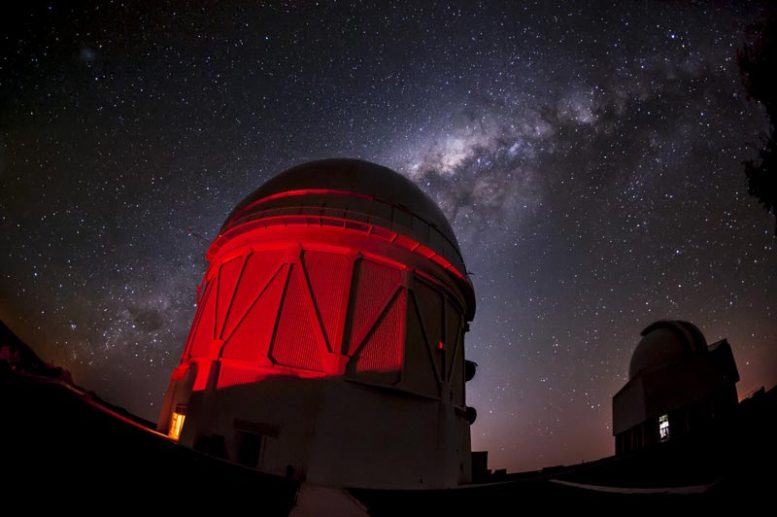
Blanco Telescope dome, where the Dark Energy Camera (DECam) is installed, with the Milky Way in the background. Researchers of the Dark Energy Survey (DES) collaboration use DECam’s images of galaxies to produce detailed maps of the matter distribution in the universe, which helps them better understand how the cosmos is expanding. Credit: Reidar Hahn/Fermilab
But when scientists subtract all the sources they already know, their map is far from empty; it still contains a gamma-ray background whose brightness varies from region to region.
“Unfortunately gamma rays don’t have a label that would tell us where they came from,” Gruen said. “That’s why we need additional information to unravel their origin.”
That’s where DES comes in. With its 570-megapixel Dark Energy Camera, mounted on the Victor M. Blanco 4-meter Telescope at the Cerro Tololo Inter-American Observatory in Chile, it snaps images of hundreds of millions of galaxies. Their exact shapes tell researchers how the gravitational pull of matter bends light in the universe – an effect that shows itself as tiny distortions in galaxy images, known as weak gravitational lensing. Based on these data, the DES researchers create the most detailed maps yet of matter in the cosmos.
In the new study, the scientists superimposed the Fermi and DES maps, which revealed that the two aren’t independent. The unresolved gamma-ray background is more intense in regions with more matter and less intense in regions with less matter.
“The result itself is not surprising. We expect that there are more gamma ray producing processes in regions that contain more matter, and we’ve been predicting this correlation for a while,” said Nicolao Fornengo, one of Ammazzalorso’s supervisors in Turin. “But now we’ve succeeded in actually detecting this correlation for the first time, and we can use it to understand what causes the gamma ray background.”
Potential hint at dark matter
One of the most likely sources for the gamma-ray glow is very distant blazars – active galaxies with supermassive black holes at their centers. As the black holes swallow surrounding matter, they spew high-speed jets of plasma and gamma rays that, if the jets point at us, are detected by the Fermi spacecraft.
Blazars would be the simplest assumption, but the new data suggest that a simple population of blazars might not be enough to explain the observed correlation between gamma rays and mass distribution, the researchers said.
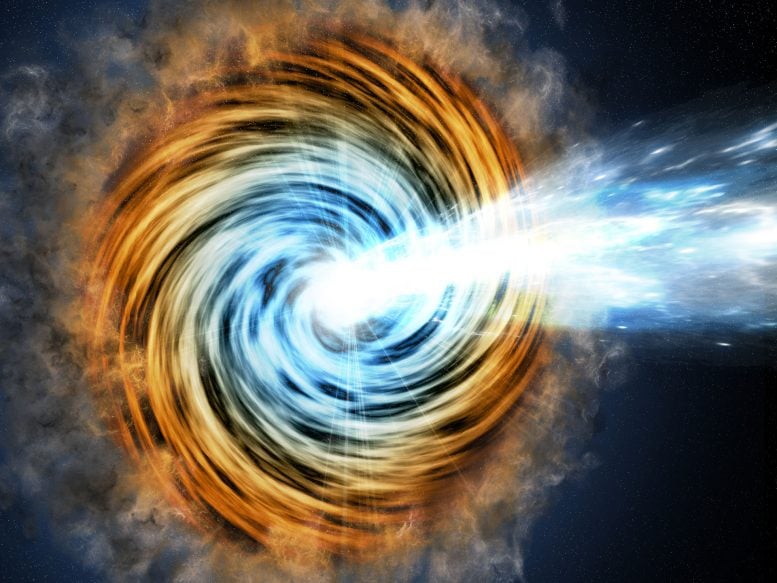
Illustration of a blazar, a powerful object that produces beams of gamma rays when material spirals into a massive black hole. Blazars are the most common extraterrestrial sources of high-energy gamma rays detected by the Fermi Gamma-ray Space Telescope. Credit: M. Weiss/CfA
In fact, our models for emissions from blazars can fairly well explain the low-energy part of the correlation, but we see deviations for high-energy gamma rays,” Gruen said. “This can mean several things: It could indicate that we need to improve our models for blazars or that the gamma rays could come from other sources.”
One of these other sources could be dark matter. A leading theory predicts the mysterious stuff is made of weakly interacting massive particles, or WIMPs, which could annihilate each other in a flash of gamma rays when they collide. Gamma rays from certain matter-rich cosmic regions could therefore stem from these particle interactions.
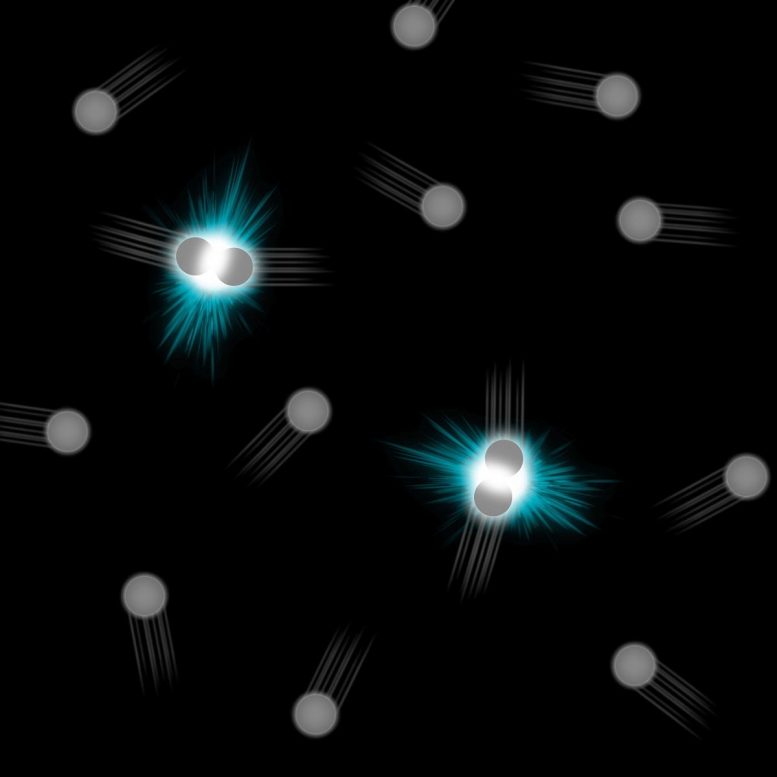
One potential source of cosmic gamma rays could be dark matter. A leading theory predicts the mysterious stuff is made of weakly interacting massive particles, or WIMPs, which could annihilate each other in a flash of gamma rays when they collide. Credit: Greg Stewart/SLAC National Accelerator Laboratory
The idea to look for gamma-ray signatures of annihilating WIMPs is not a new one. Over the past years, scientists have searched for them in various locations believed to contain a lot of dark matter, including the center of the Milky Way and the Milky Way’s companion galaxies. However, these searches haven’t produced identifiable dark matter signals yet. The new results could be used for additional searches that test the WIMP hypothesis.
Planning next steps
Although the probability that the measured correlation is just a random effect is only about one in a thousand, the researchers need more data for a conclusive analysis.
“These results, connecting for the first time our maps of gamma rays and matter, are very interesting and have a lot of potential, but at the moment the connection is still relatively weak, and one has to interpret the data carefully,” said KIPAC Director Risa Wechsler, who was not involved in the study.
One of the main limitations of the current analysis is the amount of available lensing data, Gruen said. “With data from 40 million galaxies, DES has already pushed this to a new level, and that’s why we were able to do the analysis in the first place. But we need even better measurements,” he said.
With its next data release, DES will provide lensing data for 100 million galaxies, and the future Legacy Survey of Space and Time (LSST) at the Vera Rubin Observatory will look at billions of galaxies in a much larger region of the sky.
“Our study demonstrates with actual data that we can use the correlation between the distributions of matter and gamma rays to learn more about what causes the gamma-ray background,” Fornengo said. “With more DES data, LSST coming online and other projects like the Euclid space telescope on the horizon, we’ll be able to go much deeper in our understanding of the potential sources.”
Then, the scientists might be able to tell if some of that gamma-ray glow stems from dark matter’s self-destruction.
DES is an international project with over 400 scientists from 25 institutions in 7 countries, who have come together to carry out the survey. Parts of the project were funded by DOE’s Office of Science and the National Science Foundation. NASA’s Fermi Gamma-ray Space Telescope is an international and multi-agency space observatory. The analysis used Fermi-LAT data that were publicly released by the international LAT collaboration.
Reference: “Detection of cross-correlation between gravitational lensing and gamma rays” by S. Ammazzalorso, D. Gruen, M. Regis, S. Camera, S. Ando, N. Fornengo, K. Bechtol, S. L. Bridle, A. Choi, T. F. Eifler, M. Gatti, N. MacCrann, Y. Omori, S. Samuroff, E. Sheldon, M. A. Troxel, J. Zuntz, M. Carrasco Kind, J. Annis, S. Avila, E. Bertin, D. Brooks, D. L. Burke, A. Carnero Rosell, J. Carretero, F. J. Castander, M. Costanzi, L. N. da Costa, J. De Vicente, S. Desai, H. T. Diehl, J. P. Dietrich, P. Doel, S. Everett, B. Flaugher, P. Fosalba, J. Garcia-Bellido, E. Gaztanaga, D. W. Gerdes, T. Giannantonio, D. A. Goldstein, R. A. Gruendl, G. Gutierrez, D. L. Hollowood, K. Honscheid, D. J. James, M. Jarvis, T. Jeltema, S. Kent, N. Kuropatkin, O. Lahav, T. S. Li, M. Lima, M. A. G. Maia, J. L. Marshall, P. Melchior, F. Menanteau, R. Miquel, R. L. C. Ogando, A. Palmese, A. A. Plazas, A. K. Romer, A. Roodman, E. S. Rykoff, C. Sanchez, E. Sanchez, V. Scarpine, S. Serrano, I. Sevilla-Noarbe, M. Smith, M. Soares-Santos, F. Sobreira, E. Suchyta, M. E. C. Swanson, G. Tarle, D. Thomas, V. Vikram and Y. Zhang, 31 July 2019, Cosmology and Nongalactic Astrophysics.
DOI: 10.48550/arXiv.1907.13484
arXiv: 1907.13484

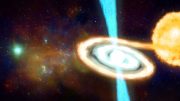

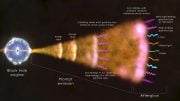

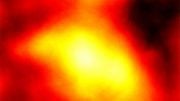


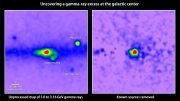
This is stretching it a bit; the whole dark energy dark matter thing – can’t measure something you can’t observe. Turn in your PhDs and get real jobs as Cosmetologists.
you stupid.
Agreed. This is not science, but pure speculation fueled by trying to save other generally accepted conjecture that doesn’t fit new discoveries. Unfortunately, this is accepted standard practice in astrophysics – everyone has agreed on the basic tenets of the cosmos, which are big bang, black holes, dark matter/energy, etc, none of which have true scientific underpinnings, and they are blatantly utilized to explain pretty much everything, which basically indicates that these people understand practically nothing about the universe they’re observing.
PS to Jim: just because I’m in agreement with you, alas, it doesn’t mean you’re not stupid, but unfortunately for Charles, I’m afraid there’s little doubt about him.
This is rather akin to the String Theory in which every wave or frequency of matter, or dark matter, can be reduced to a particle, or position in space-time. And based on this reduction, we can infer upon a hypothesis that they would interact with each other. Then we expand upon that conjecture a little further by interpreting the make up of these interacting dark matter particles and by trying to prove they are really unknown reactions of ordinary matter. I agree this would be really stretching theoretical guess work to try and support an audacious theory.
Rather the probable explanation or gamma rays lies in the ability for disintegrate, or separating, ordinary matter from dark matter.
I like your concept of dark matter
Thank You.
Dark matter flashing to dark energy as it leaves the gravity wells. Similar to water vaporizing as the pressure drops.
Perhaps the gamma radiation reacting with particles toward the center of galaxies and confined by this interaction for a time before leaking into space is the source of dark mass. This is similar to the chromodynamic interaction between quarks and gluons that, being confined by this interaction, is perceived as mass. The energy of the bosons is the energy that, being in a stable detent state, creates a distortion in space-time we perceive as mass. Could the interaction of high energy gramma radiation photons with elementary particles toward the center of a galaxy produce the effect of mass in a similar way?
… a self destruction like annihilation, that is bit virtualish…
I honestly feel dark matter exist in the unexplored oceans biosphere. Especially where there are glaciers. The below freezing temperature, the big bang theory left over supernova nova particles that formed ordinary Matter which created the earth’s tectonic plates & water which by this time dark matter was also forming from the cooling down & from the cores heat like little supernovas that decayed & emitted this dark matter/energy that caused weak gamma rays to emit & hit particles that inturn radiated stronger gamma rays that have been bouncing & feeding off h20 in space & other supernovas & the coldness to create this plasmatic dark matter that creates its own gravity & energy & under the deep ocean also creates luminous microbes that are the creatures of the deep oceans biosphere. Also at to why we have a gamma ray background..old gamma rays from since the dinos went extinct just bouncing around becoming stronger or weaker depending on the decay of stars. Dark matter just multiplying & expanding in plasmatic energy taking up the galaxy like the water is the earth. Maybe that’s why the plasma we have is harvested.
I say that to say this..we might just be held together by dark matter but made out of ordinary Matter…plasmatic beings that exude our own electromagnetic field but also have or own center of gravity on a planet that spins on its own axis & remains spherical
Isaiah James Knight M.D
How Do you explain the self destruction of a instance of a I ^ 19 particulate if by law all particles even in the I^18 cannot be totally destroyed……….
Mercer of a Alex
wide world carls while under web world lucky lucky lucky while web lucky world web under under while web carls wide lost lost wide world world while web cleaning world car under lucky lost lost web lucy lucky car web web car lucky web carls wide lost lost wide world world while web cleaning world car under lucky lost lost wide lucy lucky car web web car lucky web carls wide lost lost wide world world while web cleaning world car under lucky lost lost world lucy lucky car web web car lucky web carls wide lost lost wide world world while web cleaning world car under lucky lost under world lost
1106282839